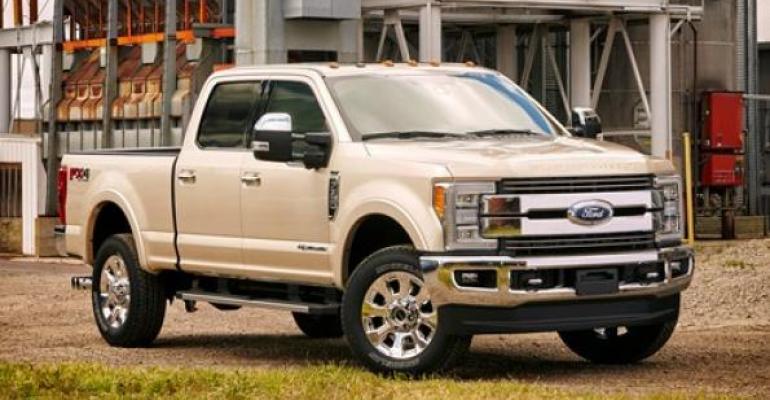DEARBORN, MI—Ford says the ̛17 F-Series Super Duty pickup it will unveil today at the Texas State Fair represents an even larger leap forward than the automaker took when it introduced its aluminum-bodied F-150 pickup a year ago. Given the level of comfort and convenience features built into the new heavy-duty trucks, in addition to its all-new aluminum body, that’s not too much of an overstatement.
“With the new Super Duty, we want to be innovators,” says Craig Schmatz, Super Duty chief engineer. “As we remove weight, we’re making Super Duty more productive by giving our customers better towing and payload capability. We’re backing up improved capability with a stronger gasoline and diesel Super Duty engine lineup.”
On sale a year from now, the ̛17 Super Duty represents the next step in Ford’s bold move to eschew steel body panels in favor or lighter-weight aluminum for the entire exterior and the truck bed. Schmatz says use of aluminum saved up to 350 lbs. (159 kg) in the Super Duty, despite significant upgrades in equipment and chassis components. The truck also features a 95% high-strength-steel fully-boxed frame that is 1.5 ins. (38 mm) taller with through-frame crossmembers. The improvements make the frame 24 times stiffer than the current truck, which uses C-channel construction, Schmatz says. C-channel is still used aft of the cab in Super Duty chassis cab models to allow for easier aftermarket upfitting.
In addition to the frame upgrades, the Super Duty gets beefier all-wheel-drive transfer case and driveline components, axles and towing hardware. Ford employs the same 0.055 in. (1.4-mm) gauge “military-grade” aluminum as it uses on the light-duty F-150 body panels, but increases the bed thickness to 0.063 in. (1.6 mm).
“This is something we learned from the F-150,” Schmatz says.
̛17 Super Duty Picks Up Light-Truck Features
The Super Duty cab from A- to C-pillar is carried over almost intact from the light-duty offering, meaning the heavy-duty truck now features many of the comfort and convenience features not typically found on big work trucks. Some common features include longer cabs, massaging front seats and inflatable rear seatbelts. Unique to the Super Duty line, however, are: dual glove boxes, a more usable center console made possible because all Super Dutys are column-shifted, a unique instrument cluster, overhead auxiliary switches and trailer brake controller. A new feature likely to be reverse-engineered into the F-150 is fully lockable storage integrated into the Super Duty rear-seat flat-load floor. The system uses flip-up panels to provide secure storage under the rear seats.
Technology abounds in the Super Duty, with much of it focused on easier and safer towing and hauling. Doug Scott, Ford truck marketing manager, says some 90% of heavy-duty truck owners say they tow regularly, compared to just 30% of light-duty owners, so the Super Duty gets seven cameras to provide a 360-degree bird’s-eye view and new features like Trailer Reverse Guidance, trailer tire-pressure monitoring, a driver-placed remote trailer camera and blindspot detection adjustable for different lengths of trailers. The new truck also gets Sync3, adaptive steering, active forward-collision braking assistance, lane-departure warning, active cruise control with exhaust braking and a remote locking and releasing tailgate.
Powertrains largely are carryover, but Ford promises more power and efficiency from each drivetrain. They include two gasoline engines, a 6.2L V-8 and a 6.8L V-10, and the second-generation 6.7L Power Stroke V-8 turbodiesel. Transmissions all are 6-speed automatics, with a new TorqShift-G transmission in the F-250. A 10-speed automatic developed jointly with General Motors arrives first in the ̛17 Raptor and then likely will roll out across the F-Series lineup.
Ford won’t specify towing and payload capacities yet, other than to assure that both will increase in the ̛17 Super Duty. The current Super Duty lists a 31,200-lb. (14,152-kg) towing capacity and 7,050-lb. (3,198-kg) maximum payload.
Staying Competitive
Differentiating the Super Duty from the light-duty truck meant employing horizontal styling elements wherever possible, such as in the strong grille crossbars and tailgate lines, to make the truck appear wider and more planted despite its 3.9-in (100-mm) higher ride height, says Gordon Platto, chief designer.
Super Duty comes in five trim levels: XL, XLT, Lariat, King Ranch and Platinum (F-150 adds one more step, Limited); three cab configurations, Regular, SuperCab and CrewCab; and two box lengths, 6.5 and 8 ft. (except chassis cab).
Scott says all the changes for the Super Duty are necessary to remain competitive in the segment, which represents about 30% of industry truck sales, especially as former “move-up” customers have begun to move back down to light-duty pickups as those trucks have become more capable in recent years. Scott says some 15%-20% of heavy-duty owners have opted to downsize in the past five years. Ford truck sales mirror the industry with 69.2% of F-Series sales going to light-duty trucks, WardsAuto data shows.
The Super Duty will be built at the Ford Kentucky Truck Plant and goes on sale in the fourth quarter of 2016.





